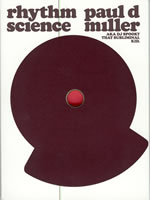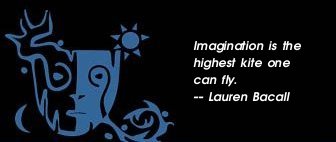|

A Book Review
Rhythm Science
By Paul D. Miller aka DJ Spooky
Cambridge, MA: MIT, 2004
The Myths of DJ Spooky: A Few First Explorations of Where We Are in 2006
A Review by Jerry Cullum, Ph.D.
copyright 2006
Dr. Jerry Cullum is senior editor of Art Papers, an
Atlanta-based international magazine of contemporary art. He reviews art
regularly for a variety of publications. He is currently organizing a small
exhibition on aspects of mythic imagination in art, scheduled to open June 7 at
Temple Gallery, Decatur, GA.
|
 |
 The
conceptual artist Paul D. Miller, better known as DJ Spooky, calls his little
monograph Rhythm Science
(Cambridge, MA: MIT, 2004) "a book for a shattered culture." A shattered
culture is very digital. Shards are sharp, like what Miller calls the "crispy"
sound of digital versus analog reproduction. A computer-generated music video
for a Japanese group that Miller cites has the buildings and cars behind them
flying apart into fragments, just like they did decades earlier in Futurist
paintings. The
conceptual artist Paul D. Miller, better known as DJ Spooky, calls his little
monograph Rhythm Science
(Cambridge, MA: MIT, 2004) "a book for a shattered culture." A shattered
culture is very digital. Shards are sharp, like what Miller calls the "crispy"
sound of digital versus analog reproduction. A computer-generated music video
for a Japanese group that Miller cites has the buildings and cars behind them
flying apart into fragments, just like they did decades earlier in Futurist
paintings.
In other words, shatteredness long predates the digital revolution: "Things
fall apart." "These fragments I have shored against my ruins." (Does anyone
read those two classic modernist poems anymore? or even the classic African
novel that borrows the first sentence as its title?)
So, says our instrumentally rational culture, you have to have rigor and
method, just to keep things from shattering further. And they're right; let the
web of global logic and just-in-time inventory recording fall apart, and avian
influenza or Marburg fever will come sliding through the gap, riding in with a
jet just arrived from some small, distant airport. There have to be some rules
somewhere. There are good ways and bad ways of doing and understanding.
But rigor and method and keeping it all apart have their limits, and lack of
rigor has its uses. The key is to understand when lack of rigor spills over
into simple sloppiness: if you maintain overly rigorous preordained categories,
if you can't think of Marburg fever and DJ Spooky and how global inventories
get put together all in the same moment, you're missing something crucial about
the world. Including how our minds put things together. Because when you read
of those three items, automatically you want to know what they have to do with
each other. You begin to make up stories that contain them.
You might make up the wrong story to explain it. In fact, those three don't
belong in the same story, although they do belong in the same set of larger
associations. Any story you make up that features only those three topics is
likely to be bad news. Some stories are just plain bad by their very nature, by
their very starting points.
My own starting point being, we live not just instrumentally but by fiction, by
telling ourselves constantly reinvented tales about the way things are. Some
fictions are docudramas while others are fairy tales. We don't just come up
with rules for understanding the world, we come up with stories, and stories
turn into whole mythologies. And mythologies, regrettably, have consequences
when we mistake them for rigorous rules and realities. In spite of which, myths
encode real ways of doing and understanding. There are good ways and bad ways
of doing myths, just like there are good ways and bad ways of doing theory.
(Readers of this magazine scarcely need to be reminded of this, but I am
revising a piece written for a somewhat broader audience.)
So let us look at DJ Spooky's take on our mythologies, as one method for
understanding this globalizing culture of the early twenty-first century, one
in which, as William Gibson says, the future is already here, but is unevenly
distributed. DJ Spooky is not rigorous, but does the job.
Miller writes in Rhythm Science
that his persona DJ Spooky (That Subliminal Kid) was born a decade ago as a
conceptual art project, at the same time as his art exhibition at Annina Nosei
Gallery. He also notes that "The art didn't sell, but [the accompanying CD]
did."
And so today he mostly uses the remix of global youth culture to speculate on
the condition of the American city, where, beginning a century ago, "When the
slave experience of cultural erasure encountered the immigrant phenomenon of
identity reconstruction in the city, the culture as a whole moved away from the
melting pot model to become a frequency centrifuge: cultures in conflict,
messages etched and pasted on every street corner, images raining down,
thoughts like rain, the city fragments and coalesces. Freud used to call the
situation 'unheimlich' or 'uncanny' but the sense of alienation and familiarity
is reminiscent of the Situationist critique of the urban landscape. They simply
called it 'psychogeographic' - the layers of the city unfold in the mind of the
person who moves through the landscape. What could be a better parallel to
'systems culture' where everyone can contribute to rhythm science; whether it's
Linux, or hip-hop, or mix-tape culture." (page 064, "Multiplex Consciousness")
Now, Mr. Miller is conflating Freud's essay on the uncanny with Civilization and
Its Discontents
, and he takes for granted a knowledge of not only Freud but the French
Situationists and their context of postwar conceptual resistance, but that's
how the remix culture works, anyway. He sees all this as intrinsically
poststructuralist strategy and inheritor of the modernist collage culture. If
it worked for James Joyce with Greek mythology and epic re-viewed in the world
of 1904 Dublin, it works for 2006 DJ culture with a slew of pre- and
postcolonial stories.
"Like an acrobat drifting through the topologies of codes, glyphs, and signs
that make up the fabric of my everyday life, I like to flip things around."
Miller's syntax fails him here and "like an acrobat" should have been the last
three words of the sentence. But the point's clear. Remixing experience,
remixing ideas, we are revisiting subjects that started with the German
Romantics and have put some travel mileage on them since. DJ Spooky doesn't
cite, because it's off to one side of his topic, the German Romantic
observation that "the poet is thoroughly irreligious; he works in the material
of religion as if it were bronze."
That's a side issue, related to the history of belief and unbelief. . .if
religious dogma becomes like an artistic material to be melted and recast in
literature, then that has consequences for culture. But that is quite another
story.
Here, it's the metaphor I want to bring to your attention. Melting something
solid so you can cast it into something else is using an idea as an artistic
medium. Sampling some spoken or written word or a piece of music so you can use
it in something else is also using an idea as an artistic medium rather than a
scholarly reference. This remix of culture has now been going on for a couple
of centuries, in other words. It has a heritage, if not quite a pedigree.
And that is where our artistic use of mythology is today, as well. Myths are no
longer tales to be retold just as they were, or even hiply updated. They are
fragments, not shored against our ruins, but remixed and sampled, just as
Joseph Campbell foretold they would be. A number of movie seasons ago, the hero
with a thousand faces was not just Frodo in Lord of the Rings but Neo in The
Matrix trilogy, even if the latter went awry because the tecno-gnostic model
was muddled. The former was a revision and retelling of an archetypal hero
tale; the latter was a re-visioning and a remixing of one.
In that sense, the brothers Wachowski were inheritors of the legacy of Friedrich
Hölderlin. And one could say the same of DJ Spooky, whose background in
philosophy and European literature, spiced with the proper amount of street
cred, has served him extremely well. Whether or not the background has served
him well enough is part of the next round of storytelling.
Return to Passages
Menu
Subscribe to the Passages
e-zine
|

